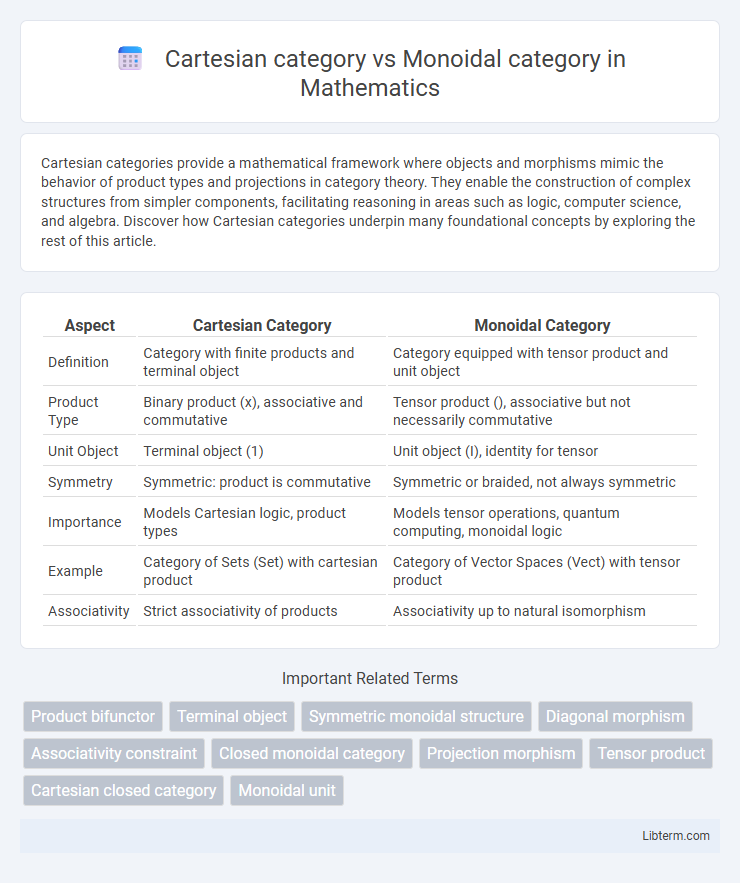Cartesian categories provide a mathematical framework where objects and morphisms mimic the behavior of product types and projections in category theory. They enable the construction of complex structures from simpler components, facilitating reasoning in areas such as logic, computer science, and algebra. Discover how Cartesian categories underpin many foundational concepts by exploring the rest of this article.
Table of Comparison
| Aspect | Cartesian Category | Monoidal Category |
|---|---|---|
| Definition | Category with finite products and terminal object | Category equipped with tensor product and unit object |
| Product Type | Binary product (x), associative and commutative | Tensor product (), associative but not necessarily commutative |
| Unit Object | Terminal object (1) | Unit object (I), identity for tensor |
| Symmetry | Symmetric: product is commutative | Symmetric or braided, not always symmetric |
| Importance | Models Cartesian logic, product types | Models tensor operations, quantum computing, monoidal logic |
| Example | Category of Sets (Set) with cartesian product | Category of Vector Spaces (Vect) with tensor product |
| Associativity | Strict associativity of products | Associativity up to natural isomorphism |
Introduction to Category Theory
Cartesian categories are monoidal categories where the tensor product corresponds to the categorical product, equipped with diagonal and terminal morphisms that enable copying and discarding of information. Monoidal categories generalize this structure by allowing tensor products that need not be products, supporting a broader range of operations without requiring copying or deletion. In category theory, understanding the distinction clarifies how structures like cartesian closed categories support functional programming semantics, while monoidal categories underpin quantum computations and resource-sensitive logics.
What is a Cartesian Category?
A Cartesian category is a category equipped with finite products, including a terminal object and binary product objects, satisfying universal properties that allow pairing and projection morphisms. It models structures where objects have a notion of "pairing," enabling the definition of product types and the duplication and deletion of information through diagonal and terminal morphisms. Cartesian categories form the foundational framework for categorical logic and relate closely to cartesian-closed categories, which model simply typed lambda calculus.
Key Properties of Cartesian Categories
Cartesian categories feature finite products with a terminal object, ensuring every pair of objects has a product characterized by projection morphisms. They possess universal properties that guarantee unique morphisms factorizing through these products, enabling well-defined notions of pairing and copying. Unlike general monoidal categories, Cartesian categories support diagonal and terminal morphisms, facilitating duplication and deletion operations crucial for modeling classical logic and functional programming.
Overview of Monoidal Categories
Monoidal categories generalize Cartesian categories by relaxing strict product requirements, replacing the Cartesian product with a tensor product that need not be a categorical product. They consist of an underlying category equipped with a bifunctor (tensor product), an identity object, and natural isomorphisms satisfying coherence conditions like associativity and unit laws. This structure enables modeling of processes and systems with parallel composition, widely applicable in areas such as quantum computing, topology, and theoretical computer science.
Fundamental Characteristics of Monoidal Categories
Monoidal categories are characterized by a tensor product operation that is associative up to a natural isomorphism and a unit object serving as an identity element for this tensor product. Unlike Cartesian categories, which have finite products and diagonal morphisms, monoidal categories emphasize a bifunctorial tensor structure that need not be product-like. This structure allows monoidal categories to model parallel composition and resource-sensitive computations in contrast to the product-based constructions in Cartesian categories.
Cartesian vs. Monoidal Structures: Core Differences
Cartesian categories feature finite products with a terminal object, enabling projections and diagonals that model duplication and deletion of data, whereas monoidal categories possess a tensor product that need not be cartesian, lacking inherent duplication or deletion. In Cartesian categories, the product structure is symmetric, associative, and has a unit, making it suitable for modeling classical logic and deterministic computation. Monoidal categories generalize this by allowing non-cartesian tensor products, crucial for quantum computing and resource-sensitive logics where copying and discarding information are restricted.
Examples of Cartesian Categories
Examples of Cartesian categories include the category of sets (Set), where products correspond to Cartesian products of sets, and the terminal object is a singleton set. Another example is the category of finite sets (FinSet), which also features product projections and diagonal morphisms, ensuring the existence of finite limits. These Cartesian categories support product structures enabling modeling of contexts with duplication and discarding, contrasting with monoidal categories where tensor products may not support such universal properties.
Examples of Monoidal Categories
Monoidal categories include examples such as the category of vector spaces with the tensor product, the category of sets with the Cartesian product, and the category of chain complexes with tensor product of chain complexes. These categories feature a bifunctor alongside a unit object, satisfying coherence conditions that generalize associativity and identity. The category of vector spaces over a field is a fundamental monoidal category used in representation theory and quantum computing.
Applications in Mathematics and Computer Science
Cartesian categories, characterized by finite products and terminal objects, find applications in logic through modeling product types and conjunction in type theory, facilitating functional programming semantics. Monoidal categories, equipped with a tensor product and unit object, underpin quantum computing frameworks and concurrency models by representing parallel composition and resource management. Both categories contribute critically to categorical semantics, where Cartesian structures align with deterministic computations and Monoidal structures capture non-deterministic or resource-sensitive processes.
Conclusion: Choosing Between Cartesian and Monoidal Categories
Choosing between Cartesian and Monoidal categories depends on the structural properties required for a specific application, with Cartesian categories providing products with diagonal and terminal maps ideal for modeling classical logic and deterministic computations. Monoidal categories offer a more general tensor product without inherent diagonal or terminal objects, suited for quantum computing, resource-sensitive logics, and processes where copying or deleting data is restricted. Understanding these distinctions guides the selection of categorical frameworks to align with computational or logical structures effectively.
Cartesian category Infographic

 libterm.com
libterm.com